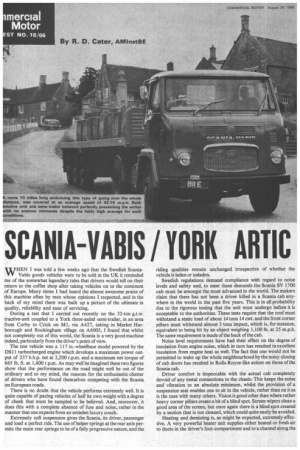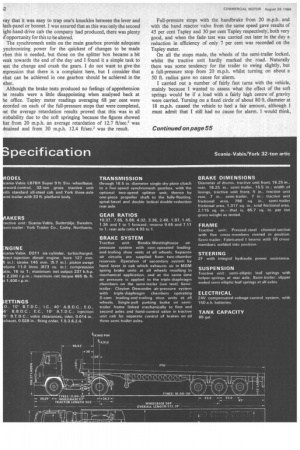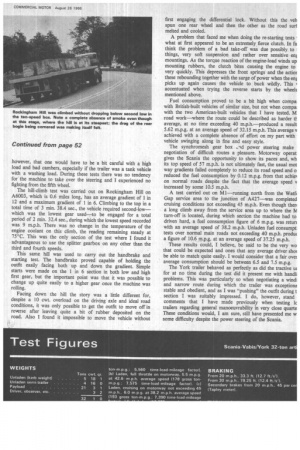SCAN1A-VABIS I YORK ARTIC
Page 52

Page 53

Page 54

Page 57

If you've noticed an error in this article please click here to report it so we can fix it.
WHEN I was told a few weeks ago that the Swedish ScaniaVabis goods vehicles were to be sold in the UK it reminded me of the somewhat legendary tales that drivers would tell on their return to the coffee shop after taking vehicles on to the continent of Europe. Many times I had heard the almost awesome praise of this machine often by men whose opinions I respected, and in the back of my mind there was built up a picture of the ultimate in quality, reliability and ease of servicing.
During a test that I carried out recently on the 32-1on g.t.w. tractive-unit coupled to a York three-axled semi-trailer, in an area from Corby to Crick on MI, via A427, taking in Market Harborough and Rockingham village on A6003, I found that whilst not completely out of this world, the Scania is a very good machine indeed, particularly from the driver's point of view.
The test vehicle was a 117 in.-wheelbase model powered by the DS11 turbocharged engine which develops a maximum power output of 237 b.h.p. net at 2,200 r.p.m. and a maximum net torque of 665 lb. ft. at 1,400 r.p.m. As may well be imagined these two figures show that the performance on the road might well be out of the ordinary and to my mind, the reasons for the enthusiastic chatter of drivers who have found themselves competing with the Scania on European roads.
There is no doubt that the vehicle performs extremely well. It is quite capable of pacing vehicles of half its own weight with a degree of cheek that must be sampled to be believed. And, moreover, it does this with a complete absence of fuss and noise, rather in the manner that one expects from an unladen luxury coach.
Extremely soft suspension gives the Scania, its driver, passenger and load a perfect ride. The use of helper springs at the rear axle permits the main rear springs to be of a fully progressive nature, and the riding qualities remain unchanged irrespective of whether the vehicle is laden or unladen.
Swedish regulations demand compliance with regard to noise levels and safety and, to meet these demands the Scania SV 1700 cab must be amongst the most advanced in the world. The makers claim that there has not been a driver killed in a Scania cab anywhere in the world in the past five years. This is in all probability due to the rigorous testing that the unit must undergo before it is acceptable to the authorities. These tests require that the roof must withstand a static load of about 14 tons 14 cwt. and the front corner pillars must withstand almost 3 tons impact, which is, for instance, equivalent to being hit by an object weighing 1,100 lb. at 25 m.p.h. The same requirement is made of the back of the cab.
Noise level requirements have had their effect on the degree of insulation from engine noise, which in turn has resulted in excellent insulation from engine heat as well. The fact that one would not be permitted to wake up the whole neighbourhood by the noisy closing of cab doors has resulted in Rolls-Royce-like action on those of the Scania cab.
Driver comfort is impeccable with the actual cab completely devoid of any metal connections to the chasis.. This keeps the noise and vibration to an absolute minimum, whilst the provision of a suspension seat enables one to sit in the vehicle, rather than on it as is the case with many others. Vision is good other than where rather heavy corner pillars create a bit of a blind spot. Screen wipers clean a good area of the screen, but once again there is a blind spot created by a section that is not cleaned, which could quite easily be avoided.
Heating and demisting is, as might be expected, extremely-effective. A very powerful heater unit supplies either heated or fresh air to ducts in the driver's foot-compartment and to a channel along the
bottom of the screen. Eighteen jets in this channel direct air to the screen to provide demisting and defrosting and—as I was told by a driver who had experience of the model—do this extremely effectively. Strict insurance regulations in Sweden have had their effect upon such simple things as grab rails, for instance, two substantial rails being fitted to each side of the cab providing safe and easy entry and exit.
Comprehensive instrumentation
Instrumentation is comprehensive with a Keinz,le seven-day route recorder incorporated in the speedometer, a rev counter, airpressure clocks—reading pressure for both circuits—and oil, watertemperature and fuel gauges.
Most aspects of the vehicle's performance on the road can only be described as perfect. The power steering gives sensitive and light control when manoeuvring in close quarters as well as at high speed on motorways. The manner in which the engine holds on to its revs in difficult conditions is truly amazing and even at the end of my 110 miles testing it still surprised me with the way in which it held on to a couple of much lighter vehicles over a difficult route. Engine noise in the cab is, as I have already intimated, of the order that one would expect in a well-appointed luxury coach and it was possible to carry on a quite normal conversation with my companion for the day.
The suspension is provided with a large degree of adjustment by which one can set it for position and weight. I found that the gear levers on.both the main and splitter units were positioned in such a
vay that it was easy to trap one's knuckles between the lever and lash-panel or bonnet. I was assured that as this was only the second ight-hand-drive cab the company had produced, there was plenty )f opportunity for this to be altered.
The synchromesh units on the main gearbox provide adequate ynchronizing power for the quickest of changes to be made vhen this is needed, but those on the splitter box became a bit veak towards the end of the day and I found it a simple task to )eat the change and crash the gears. I do not want to give the mpressiort that there is a complaint here, but I consider that vhat can be achieved in one gearbox should be achieved in the )ther.
Although the brake tests produced no feelings of apprehension he results were a little disappointing when analysed back at he office. Tapley meter readings averaging 68 per cent were ecorded on each of the full-pressure stops that were completed, ut the average retardation results proved that this was in all Irobability due to the soft springing because the figures showed hat from 20 m.p.h. an average retardation of 12.7 ft/sec.2 was
■ btained and from 30 m.p.h. 12.4 ft/see.' was the result. Full-pressure stops with the handbrake from 20 m.p.h. and with the hand reactor valve from the same speed gave results of 45 per cent Tapley and 30 per cent Tapley respectivelY, both very good, and when the fade test was carried out later in the day a reduction in efficiency of only 7 per cent was recorded on the Tapley meter.
On all the stops made, the wheels of the semi-trailer locked. whilst the tractive unit hardly marked the road. Naturally there was some tendency for the trailer to swing slightly, but a full-pressure stop from 20 m.p.h. whilst turning on about a 50 ft. radius gave no cause for alarm.
I carried out a number of fairly fast turns with the vehicle, mainly because I wanted to assess what the effect of the soft springs would be if a load with a fairly high centre of gravity were carried. Turning on a fixed circle of about 80 ft. diameter at 18 m.p.h. caused the vehicle to heel a fair amount, although I must admit that I still had no cause for alarm. I would think, however, that one would have to be a bit careful with a high load and bad cambers, especially if the trailer was a tank vehicle with a washing load. During these tests there was no tendency for the machine to take over the steering and I experienced no fighting from the fifth wheel.
The hill-climb test was carried out on Rockingham Hill on A6003, which is 0.6 miles long, has an average gradient of 1 in 12 and a maximum gradient of 1 in 6. Climbing to the top in a total time of 3 min. 38.4 sec., the vehicle required second-lowwhich was the lowest gear used—to be engaged for a total period of 2 min. 32.4 sec., during which the lowest speed recorded was 9 m.p.h. There was no change in the temperature of the engine coolant on this climb, the reading remaining steady at 75°C. This was the only section of the test where I found it advantageous to use the splitter gearbox on any other than the third and fourth speeds.
This same hill was used to carry out the handbrake and starting test. The handbrake proved capable of holding the outfit easily facing both up and down the gradient. Simple starts were made on the 1 in 6 section in both low and high first gear, but the important point was that it was possible to change up quite easily to a higher gear once the machine was rolling.
Facing down the hill the story was a little different for, despite a 10 cwt. overload on the driving axle and ideal road conditions, it was only possible to get the outfit to move off in reverse after leaving quite a bit of rubber deposited on the road. Also I found it impossible to move the vehicle without first engaging the differential lock. Without this the veh spun one rear wheel and then the other as the road surf melted and cooled.
A problem that faced me when doing the re-starting tests what at first appeared to be an extremely fierce clutch. In fa think the problem of a bad take-off was due possibly. to I things, very soft suspension and rather over sensitive eni mountings. As the torque reaction of the engine-load winds up mounting rubbers, the clutch bites causing the engine to very quickly. This depresses the front springs and the actior these rebounding together with the surge of power when the enf picks up again causes the vehicle to buck wildly. This I accentuated when trying the reverse starts by the wheels mentioned above.
Fuel consumption proved to be a bit high when compa; with British-built vehicles of similar size, but not when compai with the two American-built vehicles that I have tested. M road work—where the route could be described as harder tlaverage, at no time exceeding 40 m.p.h.—produced a result 5.62 m.p.g. at an average speed. of 32.15 m.p.h. This average v achieved with a complete absence of effort on my part with vehicle swinging along in fine and easy style.
The synchromesh gear box “nd power steering make negotiation of difficult routes a pleasure. Motorway operat gives the Scania the opportunity to show its paces and, wh its top speed of 57 m.p.h. is not ultimately fast, the usual mot way gradients failed completely to reduce its road speed and o reduced the fuel consumption by 0.12 m.p.g. from that achie) on normal roads despite the fact that the average speed v increased by some 10.5 m.p.h.
A test carried out on Ml—running north from the Watfc Gap service area to the junction of A427—was completed cruising conditions not exceeding 45 m.p.h. Even though then a long climb away from the service area up to where the 111 turn-off is located, during which section the machine had to driven hard, a fuel consumption figure of 6 m.p.g. was retun with an average speed of 38.2 m.p.h. Unladen fuel consumpti tests over normal main roads not exceeding 40 m.p.h. produc a figure of 10.6 m.p.g. at an average speed of 37.25 m.p.h.
These results could, I believe, be said to be the very wo that could be expected and ones that any average driver shot be able to match quite easily. I would consider that a fair over average consumption should be between 6.5 and 7.5 m.p.g.
The York trailer behaved as perfectly as did the tractive tu for at no time during the test did it present me with handli problems. This was particularly so when negotiating a windi and narrow route during which the trailer was exceptiona stable and obedient, and as I was "pushing" the outfit during t section I was suitably impressed. I do, however, stand comments that I have made previously when testing lc trailers regarding general manoeuvrability in very close quarte These conditions would, I am sure, still have presented me w some difficulty despite the power steering of the Scania.




















































































































